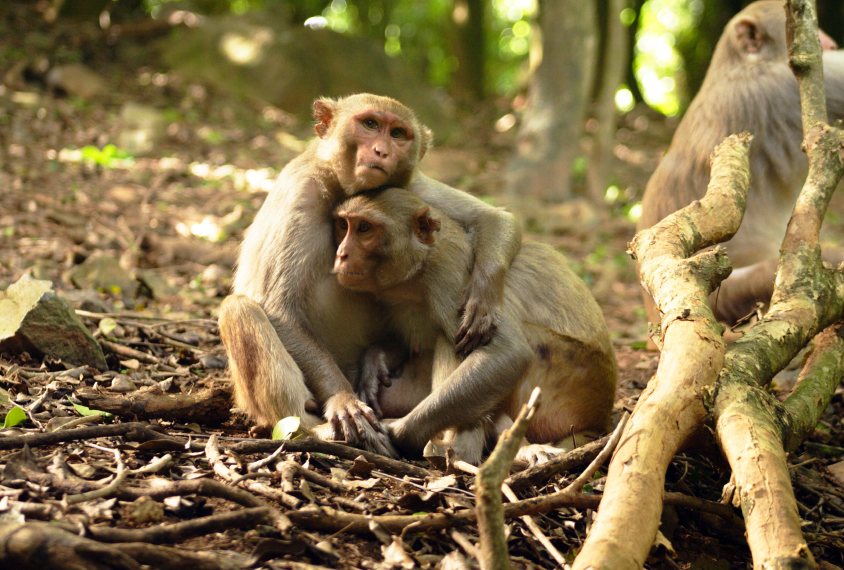
THIS ARTICLE IS MORE THAN FIVE YEARS OLD
This article is more than five years old. Autism research — and science in general — is constantly evolving, so older articles may contain information or theories that have been reevaluated since their original publication date.
The hormones oxytocin and vasopressin promote social interactions in male monkeys but make female monkeys more aggressive than usual.
Researchers presented the unpublished findings today at the 2017 Society for Neuroscience annual meeting in Washington, D.C.
Oxytocin and vasopressin play key roles in the social behavior of animals. Both hormones are being investigated as possible treatments for autism. However, few studies have directly compared how men and women respond to the treatment.
“[Monkeys] are not people, but we’re getting different effects in males and females — that should give us pause about how oxytocin might affect females with autism,” says lead investigator Michael Platt, professor of psychology at the University of Pennsylvania. Yaoguang Jiang, a postdoctoral fellow in Platt’s lab, presented the findings.
Jiang and her colleagues positioned pairs of male rhesus macaques in chairs across from one another and recorded videos of them interacting naturally for five minutes. (The monkeys were separated by pieces of clear plastic so that they could not interact physically.)
The researchers measured how much time each monkey spent gazing directly at or looking away from his companion. Direct gaze is a sign of dominance in monkeys and looking away of submission.
Looking around:
They gave one monkey in each pair either a hormone or a placebo and compared their looking behaviors.
The monkeys that inhale either hormone spend less time looking directly at their partners than the control monkeys do. The treatment also affects the untreated partners: They, too, show a decrease in the amount of time they spend looking back at their treated partners.
“It just sort of relaxes the social interaction,” Platt says.
Without treatment, one monkey in a pair naturally becomes increasingly more dominant over the other. But when one of the monkeys receives oxytocin or vasopressin, this shift in dominance is diminished.
“It’s as if under treatment, all monkeys [are] put much closer together in their social ranking,” Jiang says.
The hormones also increase the synchrony of the pairs’ looking patterns: When one monkey looks at the other, his partner is more likely than usual to meet his gaze.
“Even though the overall amount of time [the monkeys] fixate on each other decreased, they’re actually more precise in a temporal manner,” Jiang says.
The researchers found similar results when they injected the hormones into the anterior cingulate cortex, a brain area that processes others’ actions. These findings suggest that this region mediates the hormones’ effects.
Girl power:
Jiang and her colleagues then repeated the experiments using female monkeys paired with either a male or female monkey.
The treatments have no effect on the amount of time a female spends looking at another female, and they slightly increase the amount of time she spends looking at a male — the opposite of the treatments’ effect in male monkeys. Treating females also does not shake up the social ranks within pairs.
However, the hormones increase the frequency of calls females make in the presence of a male partner, as well as the number of threats they make. And these males tend to avoid looking back at them.
“The same treatments are making the girls much meaner,” Jiang says. “They’re exerting more dominance behavior, so then the males say, ‘Jesus, I better steer clear from that crazy lady.’”
Platt says his team is studying how oxytocin affects social behavior in boys and girls with Prader-Willi syndrome, a condition related to autism. People with the syndrome often have an insatiable appetite and tend to overeat. Oxytocin is known to suppress appetite.
Platt and his colleagues are exploring whether it also affects how the children look at pictures of fruits and vegetables arranged to look like faces.
Typical children would be expected to focus on the ‘eyes’ and ‘mouth’ of this arrangement, but those with Prader-Willi syndrome might focus instead on the food as something to eat, Platt says. The researchers aim to see whether these gaze patterns shift with oxytocin treatment, and whether the hormone affects boys and girls differently.
For more reports from the 2017 Society for Neuroscience annual meeting, please click here.
By joining the discussion, you agree to our privacy policy.